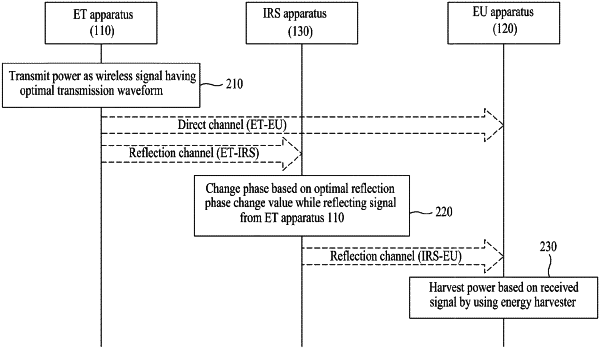| CPC H02J 50/001 (2020.01) [H02J 50/40 (2016.02)] | 12 Claims |

|
1. A computer system for wireless power transfer, comprising:
an energy transfer (ET) apparatus including a plurality of transmission antennas configured to transmit power as a wireless signal;
an energy user (EU) apparatus configured to harvest power from a received signal received by the EU apparatus; and
an intelligent reflection surface (IRS) apparatus including a plurality of passive elements configured to reflect the signal from the ET apparatus to the EU apparatus,
wherein in the computer system, a multi-path channel comprising a direct channel through which the power is directed from the ET apparatus toward the EU apparatus and a reflection channel through which the power is directed from the ET apparatus toward the EU apparatus after being reflected by the IRS apparatus is implemented, and
wherein the computer system is designed to maximize a gain of the multi-path channel in order to maximize the harvested power,
wherein the computer system sets reflection phase change values for the passive elements based on an analysis for a peak component of the received signal such that the gain of the multi-path channel is maximized and a phase of the reflection channel is aligned with a phase of the direct channel,
wherein, based on the set reflection phase change values, the passive elements change a phase of a signal transmitted from the ET apparatus to the IRS apparatus so that the phase of the reflection channel is aligned with the phase of the direct channel, and
wherein the peak component of the received signal is represented in a form of a matrix vector product of a vector comprising an effective channel matrix between the transmission antennas and the EU apparatus and reflection coefficient vectors of the passive elements.
|